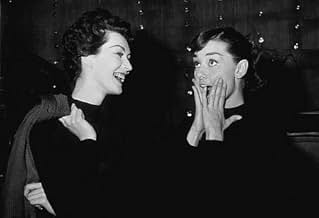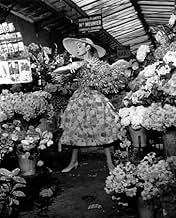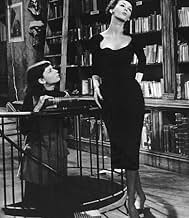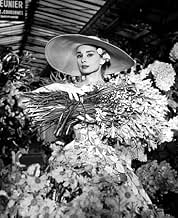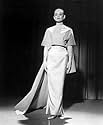AVALIAÇÃO DA IMDb
7,0/10
35 mil
SUA AVALIAÇÃO
Um ensaio improvisado de moda em uma livraria traz a descoberta de uma nova modelo no balcão da loja.Um ensaio improvisado de moda em uma livraria traz a descoberta de uma nova modelo no balcão da loja.Um ensaio improvisado de moda em uma livraria traz a descoberta de uma nova modelo no balcão da loja.
- Indicado a 4 Oscars
- 2 vitórias e 10 indicações no total
Heather Ames
- Junior Editor
- (não creditado)
Fern Barry
- Southern Wife
- (não creditado)
Brandon Beach
- Fashion Show Guest
- (não creditado)
Paul Bisciglia
- Photographer
- (não creditado)
Avaliações em destaque
You have Audrey Hepburn, you have Fred Astaire, you have Gershwin songs. Who needs a plot?
Okay, there was something of a plot, something about a Greenwich Village girl who wants to go to Paris, talk b.s. philosophy on the Left Bank, wear black clothes and no make-up. It reads like something out of one of Woody Allen's early stories - before he wrote it!
Audrey Hepburn never knew how to look bad nor act bad. But in this she looks light-years more beautiful as the proverbial Greenwich Village used-book-store Plain Jane than any Paris fashion model - then or now.
Okay, there was something of a plot, something about a Greenwich Village girl who wants to go to Paris, talk b.s. philosophy on the Left Bank, wear black clothes and no make-up. It reads like something out of one of Woody Allen's early stories - before he wrote it!
Audrey Hepburn never knew how to look bad nor act bad. But in this she looks light-years more beautiful as the proverbial Greenwich Village used-book-store Plain Jane than any Paris fashion model - then or now.
This 1957 musical is a little odd. It has a title based on an original 1920s Gershwin musical (that included the title song) which starred Fred and Adele Astaire. It was a musical and scenic valentine to France (but only one tune in it deals with France - "Bonjour Paris!". It is a spoof on the modern fashion magazines, fashions in general, and advertising - but the spoof while sharp at times is never pushed. The opening sequence, "Think Pink," describes how Kay Thompson plans a campaign to make the American woman go for "pink" clothes, accessories, toothpaste, etc., only to admit to her assistant she personally loathes the color. It takes full advantage of the attractive face and features of Hepburn, who is convinced to be a model and help push a new line of fashions in Paris. And it makes two characters into imitations of Richard Avedon the photographer (Astaire as Dick Avory) and Jean-Paul Sartre (Michel Auclair as Prof. Emile Flostre).
Avedon was a rarity - a fashion photographer who became a great artistic portrait photographer. Astaire never is shown taking pictures of great or famous people in the film but several times he demonstrates a refinement that separates him from the rest of Kay Thompson's entourage (most of whom don't care what havoc they cause, as long as they get their jobs done). He also has enough sense to question Hepburn's accepting of "empathicalism", and it's viability. Witness his moment in the bistro pouring wine to the two old codgers who are quite pleasant to him while he insults them in English. Hepburn, of course, is so insistent on the validity of her philosophical beliefs that she rejects Astaire's warnings, and jeopardizes the fashion show.
The final blow (seemingly) to the Astaire - Hepburn relationship is when he confronts Flostre at the author's home. He knocks out the Professor, and his brutality demolishes the relationship with Hepburn. But within minutes Hepburn sees another side to Flostre which is unexpected, and suddenly realizes that Astaire may be right after all.
The character of Flostre is obviously based on that of Jean-Paul Sartre, the founder of "existentialism". Based on in some details, but not in theory. "Empathicalism" has to do with trying to empathize with others so as to have a proper response to their needs and aspirations. "Existentialism" has to do with: "An introspective humanism or theory of man which expresses the individual's intense awareness of his contingency and freedom; a theory which states that the existence of the individual precedes his essence." This is from Webster's New Collegiate Dictionary. Sartre has a more complex view of man and society, and one can plow through BEING AND NOTHINGNESS to try to understand it. In fact some critics have wondered if the Nobel Prize Winner eventually got very wrong headed about his theory. But he certainly seems a meatier philosopher than his celluloid copy.
But Flostre does have the trappings of Sartre on him. He is revered by his followers world wide (such as Hepburn). He is a man with sexual appetite (as Sartre was with his long time companion and fellow writer Simone Beauvoir). And there is some traces of an anti-capitalist, even anti-American attitude in him. It is not definitely pushed, but when Astaire and Thompson break into his house during a party, they pretend they are American share cropper singers whom Flostre had brought to France to perform for his guests. Now, we never hear what this actual pair actually would sing, but judging from their background they would have to throw in some protest songs. Sartre was very critical of the U.S.A. and capitalism (today his fans have to explain Sartre's willingness to accept Russian imperialist moves under Communism in the 1940s, 1950s, and 1960s - they find it very hard to do so).
On the whole the parts of the film work well, so I give it seven stars. Kay Thompson is best recalled for being the creator of the little girl at the Plaza "Eloise", but she shows here a highly entertaining performance as Maggie Prescott, the editor who pushes and loathes pink. The film would have been better if somehow Avedon's portrait photography had been brought into the story, possibly in a final scene with Flostre as his subject. However, even without such a sequence the film is rewarding to watch, especially in the musical numbers. Astaire does equally well with Thompson and with Hepburn as his partners here.
Avedon was a rarity - a fashion photographer who became a great artistic portrait photographer. Astaire never is shown taking pictures of great or famous people in the film but several times he demonstrates a refinement that separates him from the rest of Kay Thompson's entourage (most of whom don't care what havoc they cause, as long as they get their jobs done). He also has enough sense to question Hepburn's accepting of "empathicalism", and it's viability. Witness his moment in the bistro pouring wine to the two old codgers who are quite pleasant to him while he insults them in English. Hepburn, of course, is so insistent on the validity of her philosophical beliefs that she rejects Astaire's warnings, and jeopardizes the fashion show.
The final blow (seemingly) to the Astaire - Hepburn relationship is when he confronts Flostre at the author's home. He knocks out the Professor, and his brutality demolishes the relationship with Hepburn. But within minutes Hepburn sees another side to Flostre which is unexpected, and suddenly realizes that Astaire may be right after all.
The character of Flostre is obviously based on that of Jean-Paul Sartre, the founder of "existentialism". Based on in some details, but not in theory. "Empathicalism" has to do with trying to empathize with others so as to have a proper response to their needs and aspirations. "Existentialism" has to do with: "An introspective humanism or theory of man which expresses the individual's intense awareness of his contingency and freedom; a theory which states that the existence of the individual precedes his essence." This is from Webster's New Collegiate Dictionary. Sartre has a more complex view of man and society, and one can plow through BEING AND NOTHINGNESS to try to understand it. In fact some critics have wondered if the Nobel Prize Winner eventually got very wrong headed about his theory. But he certainly seems a meatier philosopher than his celluloid copy.
But Flostre does have the trappings of Sartre on him. He is revered by his followers world wide (such as Hepburn). He is a man with sexual appetite (as Sartre was with his long time companion and fellow writer Simone Beauvoir). And there is some traces of an anti-capitalist, even anti-American attitude in him. It is not definitely pushed, but when Astaire and Thompson break into his house during a party, they pretend they are American share cropper singers whom Flostre had brought to France to perform for his guests. Now, we never hear what this actual pair actually would sing, but judging from their background they would have to throw in some protest songs. Sartre was very critical of the U.S.A. and capitalism (today his fans have to explain Sartre's willingness to accept Russian imperialist moves under Communism in the 1940s, 1950s, and 1960s - they find it very hard to do so).
On the whole the parts of the film work well, so I give it seven stars. Kay Thompson is best recalled for being the creator of the little girl at the Plaza "Eloise", but she shows here a highly entertaining performance as Maggie Prescott, the editor who pushes and loathes pink. The film would have been better if somehow Avedon's portrait photography had been brought into the story, possibly in a final scene with Flostre as his subject. However, even without such a sequence the film is rewarding to watch, especially in the musical numbers. Astaire does equally well with Thompson and with Hepburn as his partners here.
Outstanding. Beautiful. Classic. What a real lady!!!
The photo sequence in Paris has never been topped. Such a 10+ movie, I can just watch it over and over. Those are kind of strange adjectives and comments from me, especially since I'm a Sci-Fi, action, fantasy kind of movie fan.
This makes me wonder, will we ever have another Audrey?? Maybe an actress who is even close? To think that she thought she had: 1. A square face, 2. A big nose and 3. Big feet. That just shows how human and natural she really was..........
What a surprise for me to find this movie. I had never even heard of it untill it came out on DVD. S'Marvelous!!
The photo sequence in Paris has never been topped. Such a 10+ movie, I can just watch it over and over. Those are kind of strange adjectives and comments from me, especially since I'm a Sci-Fi, action, fantasy kind of movie fan.
This makes me wonder, will we ever have another Audrey?? Maybe an actress who is even close? To think that she thought she had: 1. A square face, 2. A big nose and 3. Big feet. That just shows how human and natural she really was..........
What a surprise for me to find this movie. I had never even heard of it untill it came out on DVD. S'Marvelous!!
The bookshop salesgirl Jo Stockton (Audrey Hepburn) is accidentally found by the photograph Dick Avery (Fred Astaire), who convinces the owner of the fashion magazine Quality, the powerful Maggie Prescott (Kay Thompson), that she could be the new model she wants for the magazine. Jo dreams on going to Paris to meet her guru, the philosopher Prof. Emile Flostre (Michel Auclair), but she cannot afford to pay for the travel; therefore she sees in the invitation, the chance to visit Paris. Once there, Dick falls in love for her.
"Funny Face" has a great cinematography, art direction, set decoration, costume design and most important, a charming and delightful Audrey Hepburn. Kay Thompson is also excellent. The problem is the silly screenplay that shows at least two great mistakes. The first one is the inconsistent and contradictory character Jo Stockton, presented as an intelligent and clever woman in the beginning, but later becoming absolutely shallow, acting like an irresponsible spoiled child. The second big mistake is Fred Astaire (58), thirty years old older than Audrey Hepburn (28), therefore more than twice her age, as her romantic pair. This great actor looks like her father, and there is no romantic chemistry between them. My vote is seven.
Title (Brazil): "Cinderela em Paris" ("Cinderella in Paris")
"Funny Face" has a great cinematography, art direction, set decoration, costume design and most important, a charming and delightful Audrey Hepburn. Kay Thompson is also excellent. The problem is the silly screenplay that shows at least two great mistakes. The first one is the inconsistent and contradictory character Jo Stockton, presented as an intelligent and clever woman in the beginning, but later becoming absolutely shallow, acting like an irresponsible spoiled child. The second big mistake is Fred Astaire (58), thirty years old older than Audrey Hepburn (28), therefore more than twice her age, as her romantic pair. This great actor looks like her father, and there is no romantic chemistry between them. My vote is seven.
Title (Brazil): "Cinderela em Paris" ("Cinderella in Paris")
I recently saw "Funny Face" and I was just enchanted from start to finish. This beautiful, sublime, light-hearted musical pairs the incomparable Fred Astaire and Audrey Hepburn. It was the perfect vehicle for Hepburn, and in my humble opinion, "Funny Face" ties with "The Band Wagon" as the best Fred Astaire musical of the 50's.
"Funny Face" tells the story of Jo Stockton (Hepburn) a deep and outspoken Beatnik bookseller, and Dick Avery (Astaire), a raffish but compassionate photographer for "Quality" magazine. "Quality" is run by its hilariously vapid editor, Maggie Presscott (Kay Thompson, a real scene stealer). After some unusual circumstances, Dick convinces the waifish Jo that she has model potential and should go to Paris with him. The plot is sometimes a moot point as soon as they get there, but what happens after that is song, dance, great clothes, and a beautiful romantic song and dance with Audrey and Fred on a grassy knoll. There's also a rather famous scene with Audrey descending a flight of stairs in a gorgeous red strapless dress with white gloves.
I've seen a lot of criticism for "Funny Face", and I disagree that it's shallow and anti-intellectual. What separates this movie from, say, "She's All That" is that Jo only goes to Paris as a "means to an end" for modelling, which Jo is vehemently against. She never compromises who she is, and doesn't officially fall for Dick until much later, so romance is never a motive for anything. Also, Dick admires Jo's inner beauty, even before she becomes a stunner. They are much more likable and romantic leads than in most "makeover" movies. Please don't over-analyze "Funny Face", just sit back and let yourself be spellbound. Trust me, "s'wonderful"!!
"Funny Face" tells the story of Jo Stockton (Hepburn) a deep and outspoken Beatnik bookseller, and Dick Avery (Astaire), a raffish but compassionate photographer for "Quality" magazine. "Quality" is run by its hilariously vapid editor, Maggie Presscott (Kay Thompson, a real scene stealer). After some unusual circumstances, Dick convinces the waifish Jo that she has model potential and should go to Paris with him. The plot is sometimes a moot point as soon as they get there, but what happens after that is song, dance, great clothes, and a beautiful romantic song and dance with Audrey and Fred on a grassy knoll. There's also a rather famous scene with Audrey descending a flight of stairs in a gorgeous red strapless dress with white gloves.
I've seen a lot of criticism for "Funny Face", and I disagree that it's shallow and anti-intellectual. What separates this movie from, say, "She's All That" is that Jo only goes to Paris as a "means to an end" for modelling, which Jo is vehemently against. She never compromises who she is, and doesn't officially fall for Dick until much later, so romance is never a motive for anything. Also, Dick admires Jo's inner beauty, even before she becomes a stunner. They are much more likable and romantic leads than in most "makeover" movies. Please don't over-analyze "Funny Face", just sit back and let yourself be spellbound. Trust me, "s'wonderful"!!
Você sabia?
- CuriosidadesFred Astaire's character is based on photographer Richard Avedon and his wife, Doe, who, like the character "Jo Stockton," became a noted model despite her indifference toward that profession. In fact, it is Avedon who set up most of the photography for this film, including the famous face portrait of Audrey Hepburn unveiled during the darkroom sequence.
- Erros de gravaçãoAfter Dick kisses Jo and leaves the bookstore, Jo begins to sing "How Long Has This Been Going On". As she sings to herself while looking at the mirror in the supposedly empty bookstore, someone is reflected in the mirror moving around on the second floor of the bookstore.
- Citações
Dick Avery: When I get through with you, you'll look like... What do you call beautiful? A tree. You'll look like a tree.
- Cenas durante ou pós-créditosThe opening credits, designed by film consultant Richard Avedon, consist of traditional film credit display interspersed with live action, fashion models and photographic film.
- Trilhas sonorasOverture: Funny Face/'S Wonderful/Think Pink!
(uncredited)
Lyrics by Ira Gershwin
Music by George Gershwin
Performed by Fred Astaire
Principais escolhas
Faça login para avaliar e ver a lista de recomendações personalizadas
Detalhes
- Data de lançamento
- País de origem
- Idiomas
- Também conhecido como
- La cenicienta de París
- Locações de filme
- Château de la reine blanche, Coye-la-Forêt, Oise, França(wedding dress photo shoot, Dick's marriage proposal)
- Empresa de produção
- Consulte mais créditos da empresa na IMDbPro
Bilheteria
- Orçamento
- US$ 3.000.000 (estimativa)
- Faturamento bruto mundial
- US$ 1.669
- Tempo de duração1 hora 43 minutos
- Cor
- Proporção
- 1.85 : 1
Contribua para esta página
Sugerir uma alteração ou adicionar conteúdo ausente







